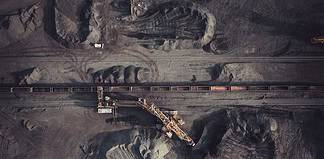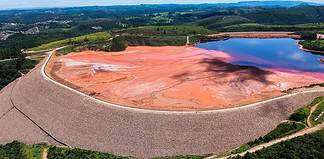 TECHNOLOGY has undergone exponential growth in the past decade; technology such as smart phones, iPods and LED televisions have integrated seamlessly into daily life, and with new developments continuing, this ingenuity shows no signs of slowing.
TECHNOLOGY has undergone exponential growth in the past decade; technology such as smart phones, iPods and LED televisions have integrated seamlessly into daily life, and with new developments continuing, this ingenuity shows no signs of slowing.
At the core of many of these new technologies is a group of lesser known elements: millions of years old, the rare earth elements (REEs) are tiny, magnetised particles that provide the essential functional component of manyof today’s most revolutionary compact electronics and energy sources.
Composed of 17 chemical elements — including 15 lanthanides elements, plus yttrium and scandium — most REEs were discovered in Scandinavia, and were often named in accordance with their place of discovery.
Despite their ‘rare’ title, REEs are not uncommon within the earth’s crust. However, due to their geochemical properties the elements are typically dispersed throughout wide areas, rather than concentrating into economically profitable ore deposits, and the process for their extraction can be both tedious and expensive. Because of this, few countries have developed REE mining sectors.
China was traditionally the world’s largest producer of REEs, supplying some 125,000t of rare earth oxide in 2008. India (2700 tonnes per annum), Brazil (550tpa) and Malaysia (380tpa) were also producers.
However, when China announced an embargo on REE export in 2009, countries including Australia, Canada, South Africa and the US stepped up their respective searches for minable rare earth deposits. Emerging rare earths producer Arafura Resources is an
Australian company looking to enter the REE trade. Named after the Arafura Sea – a body of water lying between the Northern Territory and Papua New Guinea – Arafura was listed on the ASX in 2003 after acquiring several sizeable and geologically prospective land areas, with little to no modern exploration.
Within its initial 12,000 square kilometre ground area, Arafura defined its two primary operation sites: the Nolans Bore prospect in the Northern Territory and Whyalla rare earths complex in South Australia – collectively known as the Nolans Project. Arafura’s project developments are advanced, with a completed feasibility study and defined JORC-compliant. The company is currently entering the final viability stages, with definitive feasibility study results pending.
In early September, Arafura announced it had formed a strategic partnership with Chinese rare earths industry leader and technology developer Shenghe Resources Holding to jointly develop Nolans Bore.
Under the terms of the agreement, Shenghe will provide scheduled reviews at Nolans while Arafura completes the project’s studies. On the successful completion of these final stages, the companies would work together to co-fund the mine construction, and then examine opportunities for the sale and distribution of products to Shenghe’s existing clients.
Nolans Bore
Underpinning the development of the Nolans Project is the company’s flagship Nolans Bore, 10km west of the Stuart Highway and 135km north-northwest of Alice Springs in the Northern Territory. Arafura has completed more than 90,000m of exploratory drilling at the site to date. In its defined mineral resource, published in late 2012, the company delineated a total mineral resource of 47 million tonnes of ore from the surface, grading 2.6 per cent rare earth oxides, for 1.2mt of contained rare earths. The results also included 5.4mt of phosphate and 19.5mt of uranium.
From these drills, the company separated five rare earth oxides to 99 per cent purity, including cerium oxide, didymium oxide, heavy rare earth oxide, lanthanum oxide and middle rare earth oxide. These rare earths are particularly valuable in producing clean energy technologies, including electric and hybrid vehicles, energy efficient lighting and wind turbine generators.
Arafura stated its figures supported a mine life of 22 years, based on a throughput of 1.1 million tonnes per annum of ore, for 20,000tpa of REE oxides. This was expected to generate a net present value of $4.3 billion inside its first four years.
Nolans Bore remains open at depths below 220m, providing potential to further upscale the sizeable resource inventory.
Arafura has estimated the Nolans Project could produce “the equivalent of 10 per cent of the world’s rare earth supply across the next 10 years,” which would be integral to fulfil the company’s vision to become a major global supplier of rare earths.
However, Arafura’s progress at the Nolans Project has received notable criticism, primarily due to its hefty CAPEX estimate. Calculated at $1.786 billion, Arafura’s critics have commented that the project would be barely profitable at today’s rare earth prices. Further, the presence of uranium within the deposit is expected to cause some difficulties with the permitting process.
Arafura reported that environmental studies at both Nolans Bore and Whyalla were advanced, and no significant issues had emerged to date.
However, Arafura chairman Ian Kowalick recognised the need for the company to reduce project expenditure.
“The Nolans Project has the potential for attractive returns and is one of themore significant rare earths projects in the world,” he said.
“However, while financial modelling shows excellent returns, the quantum of project funding required is large and that is an issue in current financial market conditions.”
In its September investor presentation, Arafura stated it was targeting a minimum $500 million reduction in capital costs, which would largely be accounted for in relocating intermediate chemical processing from Whyalla to Nolans Bore.
This move was aided by the discovery of an extensive aquifer system close to Nolans Bore, for predicted savings of about $160 million per year in capital, and $1.60/kg of rare earth oxide in operating costs. Arafura also noted further logistics and environmental benefits of the move, while emphasising that with the consolidation of a long term agreement with Shenghe, there was potential for significant capital and operating cost reductions.
Future outlook
Mr Kowalick said Arafura was well positioned to capitalise on the market with the Nolans Project.
“Our flagship Nolans Project is world-scale, advanced stage and contains a favourable product mix, which includes many of the ‘critical rare earths’ that are in tight supply,” he said.
The company further has a strong financial position, with more than $30 million in cash and no debt.
Mr Kowalick said the rare earths market was likely to see a medium to long term rise in prices, due to their importance in new technologies. “Despite recent softness in rare earths prices, the medium-term outlook remains promising because the factors that drive medium to long-term demand for rare earths are unchanged,” he said.
“The clean energy revolution and the need for technological innovation in many product sectors are the main drivers of the growing long-term demand for rare earths.
“This, coupled with forecast supply gaps for some rare earths that have high deprival value for end users, should see prices strengthen over the medium to long-term.”











































